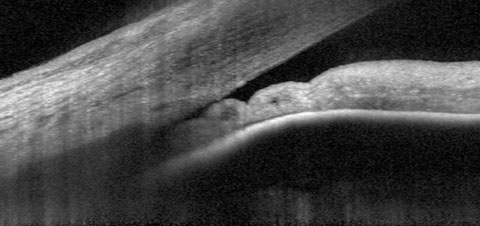 |
| OCT was found to better identify patients with early angle-closure than gonioscopy scores. Photo: James L. Fanelli, OD. Click image to enlarge. |
The data is sparse to guide clinical management of primary angle-closure suspect (PACS), with no quantitative method to identify high-risk patients. However, researchers believe anterior segment OCT measurements of angle width and iris curvature are predictive of progression, whereas gonioscopy grades are not.
A team recently used data from the Zhongshan Angle Closure Prevention (ZAP) Trial to assess biometric risk factors for progression from PACS to primary angle-closure (PAC) or acute angle-closure (AAC) and to develop statistical models that could help stratify patients with early angle-closure at risk for more severe disease. The investigators analyzed 643 mainland Chinese patients with PACS (609 nonprogressors, 34 progressors). A PAC suspect was defined as an inability to visualize pigmented trabecular meshwork in two or more quadrants based on static gonioscopy. PAC itself was defined as development of intraocular pressure above 24mm Hg or peripheral anterior synechiae. Progression was defined as development of PAC or an AAC attack.
The researchers then determined the odds ratio (OR) for various patient characteristics. They found that narrower horizontal angle-opening distance of 500μm from the scleral spur (OR: 1.10 per 0.01mm decrease), flatter horizontal iris curvature (OR: 1.96 per 0.1mm decrease), older age (OR: 1.11 per one-year increase) and iris curvature (OR: 2.48) were significantly associated with progression.
Gonioscopy scores, however, were not predictive of progression. The researchers noted that OCT measurements of biometric parameters could help identify patients with early angle-closure who are at higher risk of progression to more severe disease.
“AS-OCT measurements may provide a more clinically useful measure of angle width than gonioscopy grades, at least for predicting progression from PACS to PAC or AAC, and disagreements between the two could reflect inherent limitations of gonioscopy for evaluating eyes with PAC disease,” the researchers concluded.
Xu BY, Friedman DS, Foster PJ, et al. Ocular biometric risk factors for progression of primary angle closure disease. Ophthalmology. October 8, 2021. [Epub ahead of print]. |

